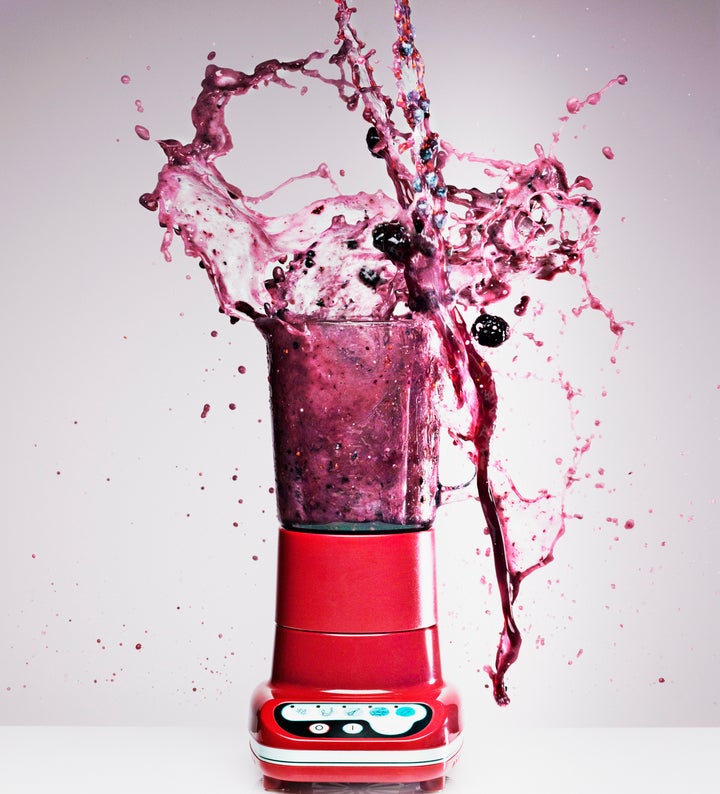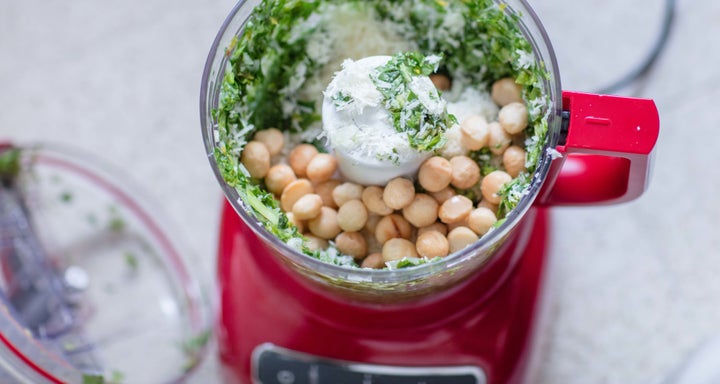
In the grand pantheon of Important Kitchen Appliances, the blender and the food processor both claim prime positions. And indeed, these pieces of equipment share many similarities: They’re both motorized and designed to mix ingredients together.
However, contrary to popular belief, these two appliances aren’t totally interchangeable. While certain foods can be equally well-made using either machine, blenders and food processors have structural differences to make them each uniquely suited to specific culinary tasks.
The Difference Between These Appliances
The short story: A blender is typically better for foods that will end up mostly liquid, whereas a food processor is better for foods that will end up being mostly solid.
Blenders and food processors both use blades and motors to accomplish their tasks, but the particular mechanisms of each device are crucially different. According to Bon Appetit, the motor of a blender is typically more powerful than that of a food processor, which creates the silky-smooth texture so characteristic of blended foods. However, blender blades “are not super sharp. In fact, they’re basically blunt objects.” Because of this, blenders are better for handling liquids and creating smooth textures.
A food processor, on the other hand, uses “ridged and razor-sharp” blades, which allow them to slice through thicker and more substantial foods. This, plus the addition of accessories like a shredder blade, allows a food processor to accomplish a number of tasks such as chopping and shredding.
Best Foods For The Blender
Cocktails, Smoothies And Sauces
When combining liquid ingredients to create a smooth, luxurious beverage or sauce, the high-octane motor of a blender is your best friend.
“A blender is best for liquids and a food processor is better for more solid ingredients. Having said that, the very powerful blenders like Vitamix and Blendtec will literally pulverize hockey pucks and iPhones,” said Atlanta-based chef Virginia Willis, author of “Secrets of the Southern Table.”
“Blenders are great for mixing liquids and making sauces. The conical shape directs everything to the blades at the bottom. Also, since [the blender pitcher is] so deep, it’s less likely to overflow. The blades of a blender aren’t that large or sharp ― what mixes things up is the powerful motor,” Willis explained.
Hollandaise
Blenders can mix up any number of delicious sauces, but the brunch staple and eggs Benedict MVP known as hollandaise particularly benefits from the textural consistency provided by serious blender motors.
“Nothing has changed the brunch game more than powerful blenders,” said culinary director Jeremy Kittelson of the Edible Beats restaurant group in Denver. “Cooks used to have to sweat over double boilers for what seemed like forever, only to often end up with a broken hollandaise and then get yelled at by the chef and have to start all over again. No more ― one only needs to heat clarified butter and put their egg mixture in a blender for perfect hollandaise.”
Purees
Whether you’re whipping up a veggie puree to serve alongside a protein or emulsifying fat into a pureed soup, a high-quality blender can aerate the mixture, resulting in a silky texture with an indulgent mouthfeel.
“I use [a Vitamix Vita-Prep blender] for pureeing soups or vegetables because it whips air into our purees, especially when we emulsify a fat into them,” said executive chef Mike Sheerin of Taureaux Tavern in Chicago. “Using a blender gives [the purees] a mayo-like consistency without all the calories.”
The motor speed of a professional-grade blender also contributes to this tool’s ability to finely process fruits and vegetables, according to chef de cuisine Geoff Lee of Byblos in Miami Beach, Florida. “The blender is capable of spinning the blade at a higher RPM than a food processor, which works well for breaking down items into their finest possible state. For example, I’ll use a blender when making my signature, a roasted red pepper puree,” Lee told HuffPost.
Cake And Pastry Batters
In another instance of blender aeration coming to the rescue, these devices are perfect for making light, airy and smooth batters for cakes and pastries. “Blenders are awesome for batters for the same reason [that] they’re great for smoothies: blender aeration,” explained Chicago-based chef and blogger Mila Furman of Girl and the Kitchen. “Whipping air into the batter creates a beautifully fluffy mixture.”
Baby Food
It’s difficult to think of an edible item that requires a soft and even texture more than baby food. Luckily, parents interested in prepping their baby’s sustenance from scratch will find a very functional friend in their blenders.
“My wife and I used our blender for making homemade baby food for our daughters,” said executive chef Ethan McKee of Urbana in Washington, D.C. “It’s super easy, saves a ton of money and gives you total control of the ingredients that go into it.”
Worst Food For The Blender
Cauliflower Rice
Using cauliflower as a keto-friendly swap for grains continues to grow in popularity, but if you want to transform this veggie into a rice substitute, it’s definitely not a task best performed with a blender. According to Taste of Home, cauliflower contains more moisture than you might expect, and when you drop florets in the blender and turn on the motor, the water inside the vegetable leaks out and leaves you with a “soggy” result.
The solution? Try a food processor instead, as the larger blades and less-potent motor will give you a consistent, rice-like texture without unnecessary dampness.

Best Foods For The Food Processor
Pie And Biscuit Dough
While blenders work beautifully for pastry batters in need of aeration, heartier doughs like the ones required for breads, pie crusts and biscuits achieve their sturdy texture thanks to the blades of a food processor. “A food processor is good for making pie dough and biscuit dough because the blades are very sharp,” Willis said.
Pasta Dough
Making pasta dough in a food processor simplifies the process and saves you time. “I use my food processor to make fresh pasta dough,” said executive chef Molly McCook of Ellerbe Fine Foods in Fort Worth, Texas. “It significantly cuts down on the prep time and helps keep a more consistent product. Different cooks might mix by hand at different strengths and speeds, but by using a food processor, you can achieve the same combinations each time, and consistency is crucial in a restaurant setting.”
Breadcrumbs, Chopped Nuts And Chopped Veggies
If you need a significant quantity of breadcrumbs or chopped produce of any kind, a food processor will keep the process moving efficiently and will provide you with a consistent product with a perfect fine-grain texture.
“I use food processors to chop and grind dry ingredients as fine as possible (like a powder). Items like breadcrumbs, nuts and coconut are best chopped in a food processor,” said chef Wayne Elias, a Los Angeles-based chef with significant experience cooking for large Hollywood festivities like Elton John’s Oscar party and Steven Tyler’s Grammy party.
“A food processor is the perfect tool when you need something that requires a large quantity of mincing,” noted chef de cuisine Tom Kaldy of Artisan in West Hartford, Connecticut. “For instance, at my restaurant, Artisan, we make a vegetable ‘risotto’ in which the vegetable we are using, whether it be cauliflower, broccoli, etc., acts as the ‘rice’ part of the risotto. In this situation, hand-chopping would be too time-consuming and would actually produce a less consistent result than a food processor blade. A blender would not be able to continuously chop the ingredient consistently, and the effort may even cause the blender to seize production.”
Textured Dips And Spreads
If you’d prefer a dip or a spread that isn’t completely smooth and pureed, you’ll want to avoid the blender. The food processor, on the other hand, will break the ingredients down and combine them while still allowing them to retain some rustic texture.
“I use a food processor instead of a blender when I want to obtain a chunky texture instead of a smooth, liquid one,” said chef de cuisine David Wang of Boleo Rooftop in Chicago. “I often use a food processor to make guasacaca, a Venezuelan guacamole, so the ingredients stay a little chunky.”
Worst Food For The Food Processor
Pureed Soup
Because the vessel of a food processor is typically more shallow than the pitcher of a blender, using a food processor to puree a larger-form dish like soup will require a great deal of time and effort, while a blender can accomplish the same task in a fraction of the time. “When pureeing soup, a food processor will work, but you will have to do it in batches,” cautioned Willis.